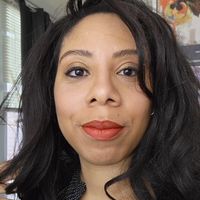Tate, Angela T.
Former Curator, Women's History
African American and African Diaspora Women’s History; Gender & Sexuality; Race; Archives; Performance; Social Movements; Black Internationalism; Celebrity Culture
Positions
- Curator, Women's History, National Museum of African American History & Culture 2021 -
Geographic Focus
- Caribbean Transnational Region
- Europe Continent
- United States of America Country
- West Africa Geographic Region
Background And Education
Education And Training
- M.A. in History, Northwestern University
Publications
Selected Publications
-
Article
- Tate, Angela. 2021. "Sounding Off: Etta Moten Barnett's Archve, Diaspora, and Radio Activism in the Cold War." Resonance, 2, (3) 395–410. https://doi.org/10.1525/res.2021.2.3.395. 2021
Activities
Responsible Collections Areas
- Women's History, Gender & Sexuality, African American Women, Intersectionality, Black Feminist History, Women's Social Movements
Teaching Overview
-
As a teacher, I believe that the classroom is a space where students and teachers can engage with each other as co-laborers in the process of learning. I have developed this belief through my background in museums and public history where the number one tenet is “shared authority.” This concept originated with Michael Frisch in the early 1990s around the methods of conducting oral history. Oral history is a field that is based on telling stories, and telling a story is what teachers do when they develop a course by writing the title and description, choose readings, construct a narrative across 10-16 weeks, and set course objectives and assignments. Students also tell stories when they sit in the classroom and turn in assignments—stories about their educational experience, their interest in the subject, their engagement in the readings, and their fulfillment of assignments. And telling a story is an active process, which means that the classroom needs to be active through the choices and actions of both the teacher and the student. Coming to academic teaching from the intensely visitor-centered field of museums means that my classroom is always created and intended to be learner-centered and learner-focused. For example, in museums, the onus is on making sure that an exhibition label tells the entire story of one object in 3-4 lines, that it is accessible in font, placement, and language, and that it is inclusive of all potential audiences. Extrapolating this to my classroom means I have high expectations of student participation and engagement (because I hope I make things exciting, accessible, and relevant), while also building in-class moments to bridge gaps in knowledge and understanding beyond the syllabus. What this can look like is instead of rushing through discussion of all of that week’s readings, I invite students to focus on one passage in one reading that confused or intrigued them—or to explain what was it about the week’s readings that didn’t engage them, and what would they have liked to read or watch or listen to and why. This is also a moment where students can evaluate my teaching and allows me to assess their learning, which could also make the syllabus a living document as opposed to a contract in which they have no say. Overall, I desire my students to express themselves in creative ways, and intentionally design my classroom to be spaces where students can be firmly grounded in methods of the historical discipline while also seeing the possibilities of history and themselves as historians.
Teaching Activities
- US History Through Monuments and Memorials Instructor 2020
- Slavery in US History and Culture Graduate Teaching Assistant 2019
- Introduction to African American History, 1600-1865 Graduate Teaching Assistant 2018
Has Knowledge Of
- French Language (Skill)
Affiliation
Member Of
Contact
Mailing Address
-
1400 Constitution Ave NW
Washington, DC 20560
USA
